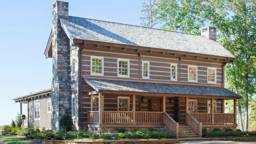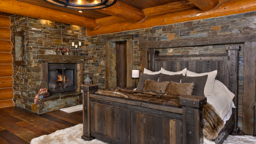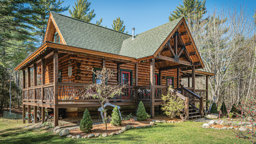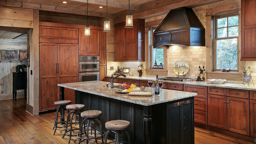
Illustration by Matt Collins
After months of planning and increasing excitement, the trucks rumble up to your site and deliver logs, lumber, windows, doors and various other building materials. The crew unloads the trucks and construction can begin. But what happens if some of those materials are stolen during construction? What if a worker breaks an ankle while working on your home? What if a fire breaks out in your partially finished home? All these “what-ifs” could keep you awake at night, or you could just make sure you’re protected against them with adequate insurance coverage. Although obtaining insurance for your log home before it’s even built may seem unnecessary, you’ll be happy to have it if you should need it.
Beginning Stages & Construction
Buying Land
Often, people purchase land with the hope of one day building a log home on the property. As a property owner, you don’t need to be overly concerned about insurance. Of course, you could take out a liability policy that would protect you in case someone was hurt on your property, says Alexander Sarno, president of the Log Home Agency. “The reality is 99 out of 100 people never buy it and never have a problem,” he says. In fact, he says, it may be difficult to find an insurer willing to provide you with this kind of insurance, unless you are already one of the agency’s customers. As soon as construction begins, however, your insurance coverage should kick in, too.
Builder's Risk Insurance
“Builder’s risk insurance covers the home and its contents—whatever is on site,” Alexander says. This kind of policy typically covers building materials and the partially built structure from damage or loss caused by theft, vandalism, weather and fire.
The premiums for a builder’s risk policy should be fairly reasonable, Alexander says, because the insurer isn’t carrying the risk of a home at full value. Most lenders will require you to carry this type of insurance before providing you with a construction loan, says Dawn Dangelis, vice president of The Construction Loan Company in Howell, Michigan. Builder’s risk insurance purchased by the home owner is different than the insurance carried by builders and general contractors. Typically, a professional builder carries insurance to cover his or her staff and workers. Before hiring a builder or general contractor, you should ask to see proof of this insurance coverage.
Worker's Compensation Insurance and Disability Benefits
If you are serving as your own general contractor, you’ll need to check into a few other types of coverage during construction. In addition to builder’s risk and a liability policy, you may need to carry worker’s compensation insurance and disability benefits for workers you employ. Typically, subcontractors, such as a plumbing company, will carry worker’s compensation for their crew members.
If, however, you employ day laborers or other assistants to help you (including friends), you may be assuming a liability risk for those workers. Worker’s compensation will cover benefits for workers who may be injured or disabled while working on your job. Typically, the premiums for this type of insurance are based on the number of workers you employ and what type of work they perform and are paid in advance. You will need to keep careful records of the people you employ and the duration of their work for you. Your insurance company will charge you or refund your money based on these records.
Ready to Move In?
Post-Construction
With construction behind you, you’ll need to begin regular home owner’s insurance on your new log home. For years, one of the common myths about log homes was that they were difficult to insure. Today, knowledgeable insurers understand the choice to use log construction should have little impact on a home owner’s ability to obtain insurance. What factors do affect the cost of insuring a home? “The more a home costs, the more expensive insurance will be,” Alexander says. Another factor is fire protection. It’s easier to insure a home that “is within reasonable response time from a fire department and not so deep in the woods that it would be impossible for a fire truck to get in there,” he says.
Good New for Log Home Owners
Alexander’s company has been insuring log homes since 1999. He started the company when he began researching log homes to build on a piece of rural property he owned. Along the way, he discovered that log homes are a good risk.
“There’s a pride of ownership that leads to impeccable housekeeping and maintenance,” he says. His agency does offer a discount for home owners who build their homes with logs that are 8 inches in diameter or larger. With the heavy timbers found in log walls, he explains, fire tends to smolder instead of bursting into flames, allowing for a longer response time from fire officials.
Also, he notes that homes built with 8-inch or larger logs may be better able to withstand windstorms, tornadoes and hurricanes. One commonly held belief about log homes and insurance does hold true. Generally, insurance companies are wary of homes with wood shake roofs. “They’re not as good a fire risk,” Alexander says.
Setting a Value
How Much to Insure?
How much home owner’s insurance you should carry is a topic to discuss with your insurance agent. Obviously, you’ll want to cover the cost of your home and its contents. Keep in mind that since your land does not carry the same risks for damage by fire or theft, you don’t need to add the value of your property to your insurance coverage. Liability insurance will protect you if someone is injured at your home. You may need to carry as much as twice the value of your assets in this type of insurance. Talk with your agent about what amount of coverage is right for you.
If you own expensive jewelry or collections, you may wish to purchase a separate rider to cover these items from damage or theft. Keep track of all your possessions by recording serial numbers and creating an inventory on videotape. The list of serial numbers and the videotape should be stored somewhere other than in your home.
A Note on Home Businesses
If you work from a home office, you may need to purchase insurance coverage for your office equipment. Additional liability insurance may be necessary if clients regularly visit your home office. Keep in mind, too, that most home owner’s policies do not cover flood damage. You may need to purchase special flood insurance through your agent or through the National Flood Insurance Program (NFIP). For more information on the NFIP, visit www.fema.gov/nfip/ or call the agency toll-free at 888-356-6329. All told, after doing your research, you’ll be adequately prepared to protect and insure your log home from start to finish—and beyond.
*A note from the editors of Log Home Living: The NAHB Log and Timber Homes Council is a great place to start your research. Visit their online library for more information and for this topic specifically take a look at, Fire Performance of Log Walls.





_11868_2023-12-20_08-12-256x288.jpg)





